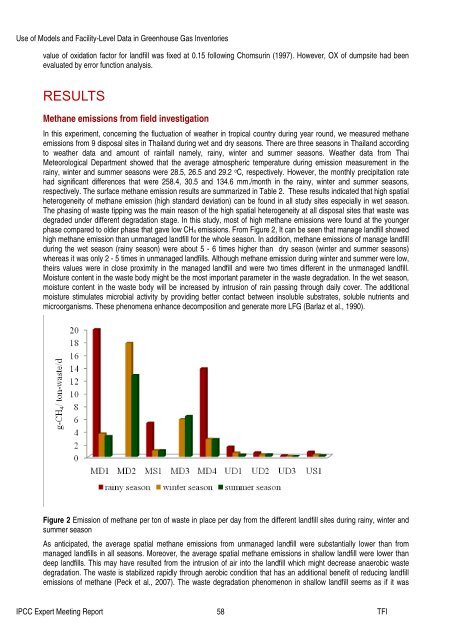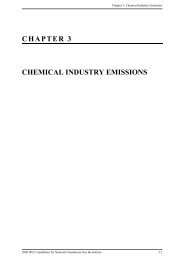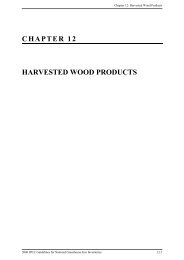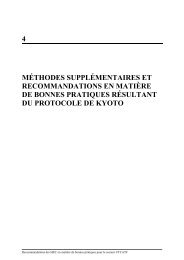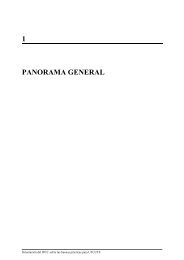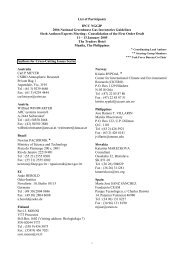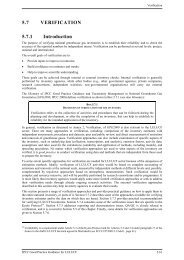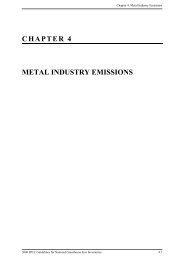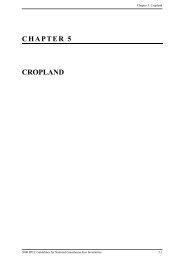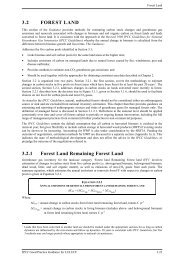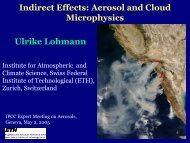Use of Models and Facility-Level Data in Greenhouse Gas Inventories
Use of Models and Facility-Level Data in Greenhouse Gas Inventories
Use of Models and Facility-Level Data in Greenhouse Gas Inventories
You also want an ePaper? Increase the reach of your titles
YUMPU automatically turns print PDFs into web optimized ePapers that Google loves.
<strong>Use</strong> <strong>of</strong> <strong>Models</strong> <strong>and</strong> <strong>Facility</strong>-<strong>Level</strong> <strong>Data</strong> <strong>in</strong> <strong>Greenhouse</strong> <strong>Gas</strong> <strong>Inventories</strong><br />
value <strong>of</strong> oxidation factor for l<strong>and</strong>fill was fixed at 0.15 follow<strong>in</strong>g Chomsur<strong>in</strong> (1997). However, OX <strong>of</strong> dumpsite had been<br />
evaluated by error function analysis.<br />
RESULTS<br />
Methane emissions from field <strong>in</strong>vestigation<br />
In this experiment, concern<strong>in</strong>g the fluctuation <strong>of</strong> weather <strong>in</strong> tropical country dur<strong>in</strong>g year round, we measured methane<br />
emissions from 9 disposal sites <strong>in</strong> Thail<strong>and</strong> dur<strong>in</strong>g wet <strong>and</strong> dry seasons. There are three seasons <strong>in</strong> Thail<strong>and</strong> accord<strong>in</strong>g<br />
to weather data <strong>and</strong> amount <strong>of</strong> ra<strong>in</strong>fall namely, ra<strong>in</strong>y, w<strong>in</strong>ter <strong>and</strong> summer seasons. Weather data from Thai<br />
Meteorological Department showed that the average atmospheric temperature dur<strong>in</strong>g emission measurement <strong>in</strong> the<br />
ra<strong>in</strong>y, w<strong>in</strong>ter <strong>and</strong> summer seasons were 28.5, 26.5 <strong>and</strong> 29.2 o C, respectively. However, the monthly precipitation rate<br />
had significant differences that were 258.4, 30.5 <strong>and</strong> 134.6 mm./month <strong>in</strong> the ra<strong>in</strong>y, w<strong>in</strong>ter <strong>and</strong> summer seasons,<br />
respectively. The surface methane emission results are summarized <strong>in</strong> Table 2. These results <strong>in</strong>dicated that high spatial<br />
heterogeneity <strong>of</strong> methane emission (high st<strong>and</strong>ard deviation) can be found <strong>in</strong> all study sites especially <strong>in</strong> wet season.<br />
The phas<strong>in</strong>g <strong>of</strong> waste tipp<strong>in</strong>g was the ma<strong>in</strong> reason <strong>of</strong> the high spatial heterogeneity at all disposal sites that waste was<br />
degraded under different degradation stage. In this study, most <strong>of</strong> high methane emissions were found at the younger<br />
phase compared to older phase that gave low CH 4 emissions. From Figure 2, It can be seen that manage l<strong>and</strong>fill showed<br />
high methane emission than unmanaged l<strong>and</strong>fill for the whole season. In addition, methane emissions <strong>of</strong> manage l<strong>and</strong>fill<br />
dur<strong>in</strong>g the wet season (ra<strong>in</strong>y season) were about 5 - 6 times higher than dry season (w<strong>in</strong>ter <strong>and</strong> summer seasons)<br />
whereas it was only 2 - 5 times <strong>in</strong> unmanaged l<strong>and</strong>fills. Although methane emission dur<strong>in</strong>g w<strong>in</strong>ter <strong>and</strong> summer were low,<br />
theirs values were <strong>in</strong> close proximity <strong>in</strong> the managed l<strong>and</strong>fill <strong>and</strong> were two times different <strong>in</strong> the unmanaged l<strong>and</strong>fill.<br />
Moisture content <strong>in</strong> the waste body might be the most important parameter <strong>in</strong> the waste degradation. In the wet season,<br />
moisture content <strong>in</strong> the waste body will be <strong>in</strong>creased by <strong>in</strong>trusion <strong>of</strong> ra<strong>in</strong> pass<strong>in</strong>g through daily cover. The additional<br />
moisture stimulates microbial activity by provid<strong>in</strong>g better contact between <strong>in</strong>soluble substrates, soluble nutrients <strong>and</strong><br />
microorganisms. These phenomena enhance decomposition <strong>and</strong> generate more LFG (Barlaz et al., 1990).<br />
Figure 2 Emission <strong>of</strong> methane per ton <strong>of</strong> waste <strong>in</strong> place per day from the different l<strong>and</strong>fill sites dur<strong>in</strong>g ra<strong>in</strong>y, w<strong>in</strong>ter <strong>and</strong><br />
summer season<br />
As anticipated, the average spatial methane emissions from unmanaged l<strong>and</strong>fill were substantially lower than from<br />
managed l<strong>and</strong>fills <strong>in</strong> all seasons. Moreover, the average spatial methane emissions <strong>in</strong> shallow l<strong>and</strong>fill were lower than<br />
deep l<strong>and</strong>fills. This may have resulted from the <strong>in</strong>trusion <strong>of</strong> air <strong>in</strong>to the l<strong>and</strong>fill which might decrease anaerobic waste<br />
degradation. The waste is stabilized rapidly through aerobic condition that has an additional benefit <strong>of</strong> reduc<strong>in</strong>g l<strong>and</strong>fill<br />
emissions <strong>of</strong> methane (Peck et al., 2007). The waste degradation phenomenon <strong>in</strong> shallow l<strong>and</strong>fill seems as if it was<br />
IPCC Expert Meet<strong>in</strong>g Report 58 TFI


